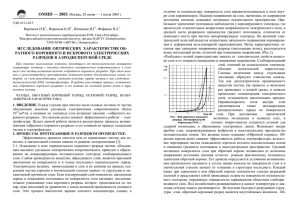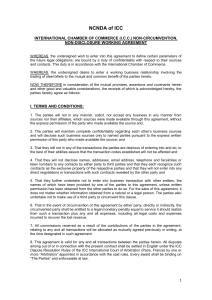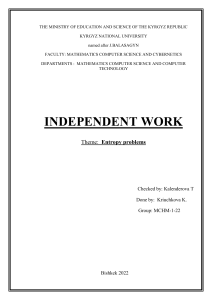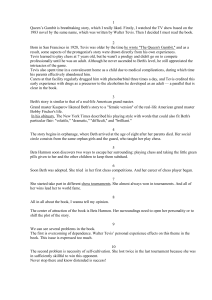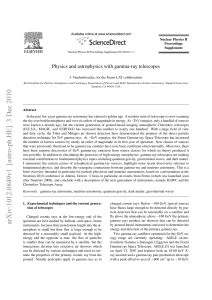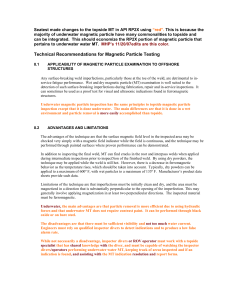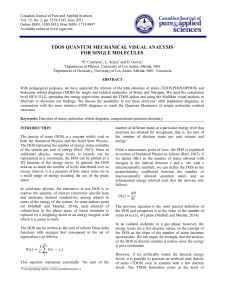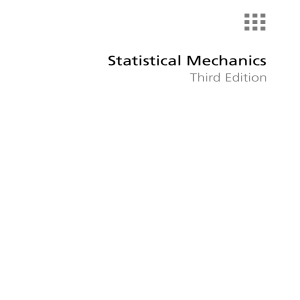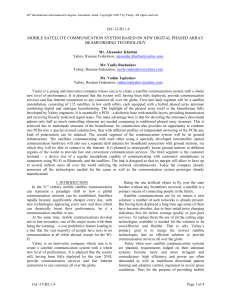Statistics of Occupation Numbers
реклама
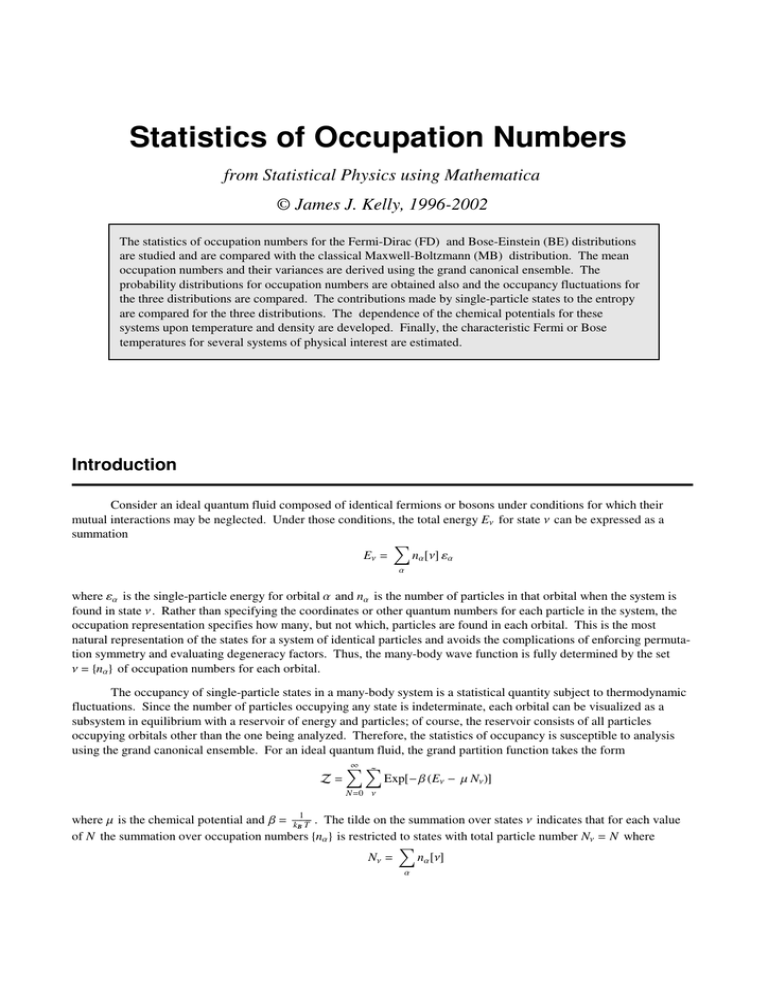
Statistics of Occupation Numbers
from Statistical Physics using Mathematica
© James J. Kelly, 1996-2002
The statistics of occupation numbers for the Fermi-Dirac (FD) and Bose-Einstein (BE) distributions
are studied and are compared with the classical Maxwell-Boltzmann (MB) distribution. The mean
occupation numbers and their variances are derived using the grand canonical ensemble. The
probability distributions for occupation numbers are obtained also and the occupancy fluctuations for
the three distributions are compared. The contributions made by single-particle states to the entropy
are compared for the three distributions. The dependence of the chemical potentials for these
systems upon temperature and density are developed. Finally, the characteristic Fermi or Bose
temperatures for several systems of physical interest are estimated.
Introduction
Consider an ideal quantum fluid composed of identical fermions or bosons under conditions for which their
mutual interactions may be neglected. Under those conditions, the total energy E for state can be expressed as a
summation
n
E
where
is the single-particle energy for orbital and n is the number of particles in that orbital when the system is
found in state . Rather than specifying the coordinates or other quantum numbers for each particle in the system, the
occupation representation specifies how many, but not which, particles are found in each orbital. This is the most
natural representation of the states for a system of identical particles and avoids the complications of enforcing permutation symmetry and evaluating degeneracy factors. Thus, the many-body wave function is fully determined by the set
n of occupation numbers for each orbital.
The occupancy of single-particle states in a many-body system is a statistical quantity subject to thermodynamic
fluctuations. Since the number of particles occupying any state is indeterminate, each orbital can be visualized as a
subsystem in equilibrium with a reservoir of energy and particles; of course, the reservoir consists of all particles
occupying orbitals other than the one being analyzed. Therefore, the statistics of occupancy is susceptible to analysis
using the grand canonical ensemble. For an ideal quantum fluid, the grand partition function takes the form
Exp
E
N
N 0
1
where is the chemical potential and
. The tilde on the summation over states indicates that for each value
kB T
of N the summation over occupation numbers n is restricted to states with total particle number N
N where
N
n
2
occupy.nb
The temperature and chemical potential are determined by the constraints upon energy and density, respectively.
Fortunately, the separability of the total energy and particle number for an ideal quantum fluid allows the grand partition function to be expressed in the form
Exp
n
n
where each sum over n is now independent, restricted only by the Pauli exclusion principle for fermions. Thus, the
summation over total particle number N effectively eliminates the constraint upon the occupation numbers. Therefore,
the grand partition function for the many-body system factorizes into products of single-orbital grand partition functions
n
E
of the form
Exp
n
n
where is the chemical potential established by the reservoir and n is the number of particles in orbital . Finally,
the thermodynamic functions are obtained using the grand potential
kB T Log
which for an ideal quantum fluid reduces to a summation over the contributions made by each orbital.
The statistics of quantum systems are intimately related to the intrinsic angular momentum (spin) of their
constituents. Systems composed of identical particles with integer spin, generically classified as bosons, obey Bose-Einstein (BE) statistics for which the many-body wave function is symmetric with respect to permutation of particle
coordinates and the summation over occupation numbers extends from 0 to . Conversely, systems composed of
identical particles with half-integral spin, generally classified as fermions, obey Fermi-Dirac (FD) statistics for which
the many-body wave function is antisymmetric with respect to particle exchange and the summation over occupation
numbers is limited to 0 or 1 particles in each unique (fully specified) single-particle orbital. The prohibition against
more than one fermion occupying any orbital is known as the Pauli exclusion principle and has profound consequences
for both the structure and the thermodynamics of Fermi-Dirac systems. Finally, it is instructional to compare BE and
FD statistics with classical or Maxwell-Boltzmann (MB) statistics for which permutation symmetry is restored using the
Gibbs prescription even though MB statistics do not accurately describe real quantum systems. The summation over
occupation numbers extends from 0 to for the MB distribution also, but the Gibbs prescription must be applied
during the factorization of the grand partition function, as discussed below.
For each distribution, the probability that a given orbital contains n particles has the form
Pn
Exp
n
The mean occupancy of that orbital is then
n
Pn n
n
and the variance in occupancy is
2
n
n
2
kB T
n
Note that P n depends implicitly upon T and and upon any external variables, such as volume, which govern the
values of . Hence, when comparing the various probability distributions, often it is useful to eliminate in favor of
n . Finally, it is useful to express the relative fluctuation in occupation numbers as
.
n
occupy.nb
3
The chemical potential is determined by the mean density of the system. We can obtain the total particle
number from the occupation probabilities using the summation
N
n
0
n
For a continuous spectrum of single-particle energy levels, the summation over occupation numbers is accomplished
through integration against the density of states,
. Although the mean particle number is a statistical variable
within the grand canonical ensemble, its distribution is nevertheless extremely sharp for macroscopic systems. Hence,
we can generally assume that N and V are determined by external constraints and thereby related the chemical potential
directly to the density.
In this notebook we concentrate on the statistics of occupation numbers, comparing the BE and FD distributions
with the classical MB model. A summary of the symbolic results is provided at the end of this notebook. The thermodynamics of ideal Fermi and Bose gases are developed in more detail in the notebooks fermi.nb and bose.nb, respectively.
Glossary:
= number of particles
V
= volume
T
= temperature
kB
= Boltzmann constant
g
= energy-level degeneracy
= single-particle energy
k
= single-particle wave number
= density of states wrt energy
k
= density of states wrt momentum
= thermal wavelength
nQ
= quantum concentration
= chemical potential
z
= fugacity
1
= grand partition function for single orbital
1
= grand potential for single orbital
S1
= entropy for single orbital
Pn
= probability for finding n particles in a particular state
n
= mean occupation number
= standard deviation for occupancy
= relative fluctuation in occupancy =
Tc
F
kF
n
= critical temperature for Bose-Einstein condensation
= Fermi energy
= Fermi momentum
4
occupy.nb
Many quantities below also include either superscripts or subscripts identify the symmetry type as FD, BE, or MB.
Initialization
Defaults, packages, and symbols
ClearAll "Global` " ;
Off General::spell, General::spell1 ;
$DefaultFont
"Times", 12 ;
FontFamily "Times", FontSize
$TextStyle
12, FontSlant
"Italic" ;
Needs["Utilities`Notation`"];
Needs["Miscellaneous`PhysicalConstants`"];
Needs["Miscellaneous`Units`"];
Needs["Graphics`Master`"]
Symbolize kB ; Symbolize nx_ ; Symbolize x_ ;
Symbolize x_ ; Symbolize Tx_ ; Symbolize x_ ;
x_
x_
x_
Symbolize 1 ; Symbolize 1 ; Symbolize S1
Symbolize n ; Symbolize nx_
FundamentalConstants
BoltzmannConstant
kB
,
PlanckConstantReduced
Joule
Kelvin
Joule Second
;
Error messages
Several annoying error messages can be suppressed, if desired, but should be enabled when developing or debugging
code.
Off
Off
Off
Off
Off
Solve::"ifun" ;
NIntegrate::"inum" ;
NIntegrate::"ncvb" ;
NIntegrate::"slwcon" ;
General::"ovfl" ;
Establish transformation rules
MyAssumptions
m 0, V 0, g
0, kB
0, n_
0, n
0, T
0,
0,
0,
0,
0 ;
occupy.nb
5
MySimplify Simplify #, MyAssumptions &;
MyFullSimplify FullSimplify #, MyAssumptions &;
Rules for changing variables
a
0, a_. kB T
TtoY
TtoLambda
m kB
2
muToZ
a , a_.
ay ;
;
m kB T
g V nQ
lambdaToQC
kB T
;
2
2
lambdaToT
a_.
2
2
T
,
1 3
;
kB T Log z ;
Thermodynamic functions
Given a single-orbital grand partition function or grand potential, these thermodynamic functionals evaluate the grand
potential, the mean energy, the single-orbital entropy, the mean occupancy, and occupation variance for that orbital.
grand
_ :
kB T Log
_ : kB T2
energy
entropy
_ :
T
1
.
T Log
;
kB T
1
.
kB T
;
;
;
nOccupy _ :
nVariance _ : kB T
nOccupy
;
Density of states
Evaluate the density of states for nonrelativistic gas in 3 dimensions in terms of both momentum and energy.
g V k2
4
k
;
2m
k
k
g m3 2 V
2 2
;
2
k
k
3
2
3
. k
k
2m
PowerExpand
6
occupy.nb
Maxwell-Boltzmann distribution
Evaluate mean occupation number and chemical potential
Although the semi-classical Maxwell-Boltzmann distribution doesn't actually pertain to any real quantum
system, it is nevertheless instructive to compare the FD and BE distributions to this classical model. Therefore, we
begin with that model. Classically, the degeneracy for a state of N identical particles described by occupation numbers
n would be g
N
n , but we must now divide by N to resolve the Gibbs paradox so that
g
1
n becomes the proper statistical weight for the MB distribution. Then, as discussed in the introduction,
the grand partition function can be factored, such that
Exp
MB
1
n
n
n 0
MB
1
MB
1
grand
kB T
nMB
PowerExpand
kB T
nOccupy
MB
1
Simplify
kB T
muTonMB
Solve n
nMB ,
1
kB T
1
kB T
kB T Log n ,
MB
1
1, 1 ,
. muTonMB
kB n T
Probability distribution for occupation numbers
The probability that an orbital with energy contains n particles is given by the grand canonical distribution
where the statistical weight is determined by the Gibbs prescription. The Boltzmann factor for the grand canonical
ensemble is determined by the energy relative to the chemical potential, where the temperature and chemical potential
are established by the reservoir (here composed of particles in other orbitals). Hence, it is instructive to express that
probability in terms of the mean occupancy, n , instead of the chemical potential.
PMB n_, , ,
n
n
Exp
n
n
MB
1
occupy.nb
7
PMB n_, n
n
n
PMB n, , ,
. muTonMB
Simplify
n
n
Thus, in classical statistics the occupation number is governed by the Poisson distribution based upon a mean occupation number n given by a Boltzmann factor with the energy expressed relative to the chemical potential. The chemical
potential depends upon density and temperature, as derived above. The fluctuation in occupation numbers is given by
the variance, which for the Poisson distribution is simply n . Thus, the relative fluctuation in occupancy is 1 for the
n
MB gas.
nVariance
MB
MB
1
. muTonMB
n
MB
MB
. muTonMB
nMB
1
n
For later comparisons it is also useful to note that the ratio of probabilities for successive values of n is inversely
proportional to n itself.
PMB n
1, n
PMB n, n
. muTonMB
.
n
1
nn
Simplify
n
n
Relate chemical potential to density
The total particle number is obtained by integrating the mean occupation number as a function of energy against the
density of states.
.
MB
Solve
Integrate
1
2
2
m
2
, 0,
, Assumptions
Re
1
kB T
0
,
MySimplify
3
Log
m 2
gV
MySimplify
2
. TtoLambda
nMB ,
MB
. lambdaToQC
Log nQ
g nQ V
2 3
Recognizing that the Maxwell-Boltzmann distribution can only be applied when the quantum concentration, nQ is
small, we conclude that should be large and negative when the MB distribution is applicable.
Examples
Here we evaluate the quantum concentrations and chemical potentials for several systems of interest. Unless explicitly
stated otherwise, SI units are employed. Hence, when defining the physical parameters we convert to SI units and then
remove the tags for the units when performing numerical calculations.
8
occupy.nb
Helium gas at STP
heliumSTPValues
g
Join
1,
Mole AvogadroConstant, V
4 Convert AtomicMassUnit, Kilogram
m
. lambdaToT . T
TT
Meter3
Mole
,
, FundamentalConstants ;
Kilogram
TT_, values_ :
MolarVolume
. values
273, heliumSTPValues
5.28309 10
11
273, heliumSTPValues
quantumConcentration
3.96183 10
MB
V
. heliumSTPValues
6
. lambdaToT . heliumSTPValues . T
kB T
3
273
12.4388
Since the quantum concentration is quite small for this system, the classical approximation should be adequate. The
chemical potential is large and negative.
Liquid helium
liquidHeValues
Join
g
1,
V density, density
4 Convert AtomicMassUnit, Kilogram
m
Kilogram
quantumConcentration
N
T, liquidHeValues
3
density
146
m
,
, FundamentalConstants ;
. liquidHeValues
.T
2
5.169
MB
kB T
. lambdaToT
. liquidHeValues . T
2
1.64268
Since the quantum concentration for liquid helium is quite large, the MB distribution is no longer applicable.
occupy.nb
9
Bose-Einstein distribution
Systems composed of identical particles with integer spin, namely bosons, obey Bose-Einstein statistics. In this
section we derive the mean occupation number and its dispersion using the formalism of the grand canonical ensemble,
as discussed in the Introduction. We also evaluate the dependence of the chemical potential upon density and temperature and consider several representative systems.
Evaluate mean occupation number
The summation over occupation numbers extends from 0 to
BE
1
Exp
for bosons.
n
n 0
1
BE
1
kB T Log
nBE
BE
1
grand
kB T
1
kB T
BE
1
nOccupy
FullSimplify
1
1
kB T
Because nBE must be nonnegative, it is clear that
must also be positive. Hence, if we choose the energy scale to
place the ground state at zero energy, we conclude that the chemical potential for an ideal BE gas must be negative.
For a given density we shall find that the chemical potential is a monotonically decreasing function of temperature.
Thus, for very low temperatures the chemical potential may become so small that the occupancy of the ground state
becomes so large that practically all particles are found in that one state. This is the origin of Bose condensation.
However, under those conditions we must examine the excitation spectrum more carefully — the customary density of
states formula is not sufficient when becomes similar to the spacing between energy levels. The critical temperature
where the chemical potential goes to zero depends upon density, and is determined below.
muTonBE
Solve n
kB T Log 1
BE
1
. muTonBE
kB T Log 1
n
nBE ,
1
,
n
Simplify
1, 1 ,
1
kB T
1
kB T
MySimplify
10
occupy.nb
Probability distribution for occupation numbers
The probability that an orbital with energy contains n particles is given by the grand canonical distribution as
specified by the temperature and chemical potential established by the reservoir (here composed of particles in other
orbitals). It is instructive to express that probability in terms of the mean occupancy, n , instead of the chemical
potential.
Exp
PBE n_, , ,
1
PBE n_, n
n
1
PBE n
FullSimplify
BE
1
1 n
n
n
PBE n, , ,
. muTonBE
MySimplify
1 n
n
1, n
PBE n, n
. muTonBE
Simplify
n
1
n
Thus, in BE statistics the occupation number is governed by the geometric distribution for which the ratio of probabilities for successive values of n is constant, whereas for the MB distribution that ratio is inversely proportional to n .
Hence, the permutation symmetry for bosons enhances occupancies relative to classical statistics for independent
particles. Similarly, the fluctuations are also enhanced by a factor of 1 n relative to classical (MB) statistics by the
requirements of permutation symmetry for identical bosons.
BE
1
nVariance
BE
n 1
Simplify
n
BE
BE
. muTonBE
. muTonBE
nBE
MySimplify
1
n
1 n
Determine critical temperature
Bose condensation occurs when the chemical potential reaches zero. For lower temperatures it is then longer
possible to accommodate all particles in excited states and it becomes necessary for a macroscopic number of particles
to reside in the ground state. The fraction of the total number of particles in the ground state increases as the temperature is reduced, reaching unity at absolute zero. The total number of particles in excited states can be obtained by
integrating the mean occupation number against the density of states. Note that the ground state at zero energy is not
counted when a continuous density of states is employed.
dNdx
kB T
nBE
NexcCritical
dNdx x
0
g kB m T
2
.
3 2
V Zeta
2
3 2
3
3
2
0,
x kB T
. lambdaToT
. TtoLambda;
MySimplify
occupy.nb
11
quantumConcentrationCritical
3
NexcCritical
. lambdaToT
gV
MySimplify
N
2.61238
For a given density, the Bose condensation occurs for the critical temperature for which the quantum concentration
reaches its critical value.
quantumConcentrationCritical
c
density
1
density
1.37725
Tc
1 3
1 3
N PowerExpand
3.3125 density2
kB m
3
2
2
m kB
c
2
2
Temperature dependence of chemical potential and occupancy
The chemical potential for fixed temperature and density must be determined by numerical solution of an integral
equation. An interpolation function is then used to represent the temperature dependence of the chemical potential and
to plot the occupation number distribution for finite temperature.
Here we express energy and chemical potential in units of kB Tc and temperature as
V
Nexc z_
Exp
z
1
,
, 0,
3
V PolyLog
3
3
2
,z
eq1 z_, _ :
zBE
2 Integrate
3
Nexc z
c
V
3
3 2
. density
V
_ : z . FindRoot Evaluate eq1 z,
pointsNearTc
Prepend Table
pointsAtLargerT
points
T Tc .
,
Log zBE
Table
,
,
Log zBE
, z, 0.7, 0.75
, 1.2, 1.5, 0.1
,
Join pointsNearTc, pointsAtLargerT ;
Clear chemicalPotentialBE ;
chem Interpolation points ;
chemicalPotentialBE _ : chem
chemicalPotentialBE _ : 0 ;
;
1;
V
1;
, 1., 0.
, 2, 5, 0.5
;
;
12
occupy.nb
DisplayTogether ListPlot points, PlotStyle AbsolutePointSize 4
Plot chemicalPotentialBE
,
, 0, 5 ,
PlotLabel "BE chemical potential", GridLines Automatic,
Frame True, FrameLabel
"T Tc ", "
kB Tc " ;
,
BE chemical potential
0
k B Tc
2
4
6
0
1
2
3
4
5
T Tc
Clear temp ;
temp _ : nBE
. kB 1, T
,
chemicalPotentialBE
;
,
, 0, 2 , PlotRange
0, 2 , 0, 5 ,
nBEplot _ : Plot temp
PlotLabel "BE occupation number", GridLines None, Frame True,
FrameLabel
"
kB Tc ", "n" , DisplayFunction Identity ;
Show[{nBEplot[1.1],nBEplot[2],nBEplot[5]},
DisplayFunction $DisplayFunction];
BE occupation number
5
4
n
3
2
1
0.25
0.5
0.75
1
1.25
kB Tc
1.5
1.75
2
occupy.nb
13
Plot3D temp
,
, 0, 2 ,
, 1.01, 2 , PlotRange
PlotLabel "BE Mean Occupancy", AxesLabel
"
DisplayFunction $DisplayFunction ;
0, 2 , 1, 2 , 5, 1
kB Tc ", "T Tc ", "n" ,
,
BE Mean Occupancy
5
4
n 3
2
1
0
2
1.8
1.6
1.4 T Tc
0.5
kB Tc
1
1.2
1.5
2
1
Examples
Here we evaluate the Bose critical temperature for several systems of interest. Unless explicitly stated otherwise, SI
units are employed. Hence, when defining the physical parameters we convert to SI units and then remove the tags for
the units when performing numerical calculations.
Helium-4
Liquid helium-4 undergoes a phase transition to a superfluid phase at a temperature of 2.17 kelvins at atmospheric
pressure. This phase transition is related to the Bose-Einstein condensation.
liqHe4Values
m
c
g
1,
V density, density
4 Convert AtomicMassUnit, Kilogram
Kilogram
146
m
,
, FundamentalConstants ;
. liqHe4Values
4.91659 10
Tc
Join
10
. liqHe4Values
3.15218
Although liquid helium is not really an ideal (noninteracting) gas, it is intriguing to observe that the Bose condensation
temperature is close to the superfluid transition temperature.
14
occupy.nb
Rubidium in ultracold atomic trap
Recently, there have been several reports of Bose-Einstein condensation in ultracold gases in low-density
atomic traps. The densities are so low that interactions are relatively unimportant and the gas is nearly ideal. The first
observation using rubidium was made by Anderson et al., Science 269 (95) 198. Although it is difficult to determine
the density of the system, the following estimate is probably reasonable.
rubidiumValues
m
Tc
Join
g
1,
V density, density
87 Convert AtomicMassUnit, Kilogram
Kilogram
1019 ,
, FundamentalConstants ;
. rubidiumValues
8.5728 10
8
50
. lambdaToT . T
109
c
. rubidiumValues
1.30941
meanSpacing
density
1 3
Convert Meter, Angstrom
. rubidiumValues
N
4641.59 Angstrom
Thus, at the density estimated for the trap the mean interatomic spacing is much larger than the typical interaction range
and for a temperature of 50 nanokelvins the thermal wavelength is already larger than the critical value for Bose-Einstein condensation. Therefore, a trap with these characteristics is capable of producing ideal Bose-Einstein
condensation.
Electron pairs
Superconductivity occurs when the interaction between electrons and the lattice result in pairing of electrons
with opposite spins and momenta. These Cooper pairs are then bosons with twice the electron mass. Although hardly
an ideal Bose gas, it is nevertheless of some interest to determine the Bose critical temperature even though a proper
theory of superconductivity is beyond the scope of this course.
cooperValues
density
Tc
Join
g
5 1028 , m
1,
V density,
2 ElectronMass
, FundamentalConstants ;
Kilogram
. cooperValues
19877.1
A gas of Cooper pairs is clearly highly degenerate. However, a proper treatment of the Cooper-pair model must be
rather more sophisticated than this "frivolous" model.
occupy.nb
15
Fermi-Dirac distribution
Systems composed of identical particles with half-integral spin, namely fermions, obey Fermi-Dirac statistics. In this
section we derive the mean occupation number and its dispersion using the formalism of the grand canonical ensemble,
as discussed in the Introduction. We also evaluate the dependence of the chemical potential upon density and temperature and consider several representative systems.
Evaluate mean occupation number
The Pauli exclusion principle for fermions limits the occupation number for each orbital to the values 0 or 1.
1
FD
1
Exp
n
n 0
1
FD
1
FD
1
grand
kB T Log 1
nFD
kB T
FD
1
nOccupy
FullSimplify
1
1
kB T
muTonFD
Solve n
kB T Log
FD
1
. muTonFD
kB T Log
1
nFD ,
1, 1 ,
1
,
n
1
kB T
MySimplify
1
kB T
MySimplify
1
1
n
Probability distribution for occupation numbers
The probability that a particular orbital contains n particles, where n can be only either 0 or 1 for fermions, is
given by the grand canonical ensemble as follows.
PFD n_, , ,
Exp
n
FullSimplify
FD
1
n
1
PFD n_, n
1
n
1 n
PFD n, , ,
nn
. muTonFD
MySimplify
16
occupy.nb
Table PFD n, n ,
1
n, 0, 1
. muTonFD
Simplify
n, n
Thus, in FD statistics the mean occupation number, n , can be interpreted as the probability that a state is occupied and
1 n is then the probability that it is vacant, those being the only two possibilities for fermions. The fluctuation in
occupation numbers is suppressed by a factor of 1 n relative to the classical occupation probability due to the
requirements of permutation symmetry. Thus, at low temperatures these fluctuations are quite severely damped for
states below the chemical potential for which the occupancy is near unity (see figure below).
Simplify
FD
1
. muTonFD
nFD
1
FD
1
. muTonFD
n n
FD
FD
nVariance
FullSimplify
n
n
Evaluate Fermi energy and momentum
The Fermi momentum, kF , is defined to be the momentum of the highest occupied state when each available
state is filled in order of increasing energy until all particles have been accommodated. The corresponding energy is
called the Fermi energy, F , and is equal to the chemical potential for T 0 . For a completely degenerate Fermi gas,
the average single-particle energy is then 35 F and the total internal energy is simply 35 N F . Similarly, the pressure
for a nonrelativistic ideal gas is 23 of the energy density. Thus, we define pDegenerate to be the pressure for a completely degenerate Fermi gas.
kmax
kF
61
kmax . Solve
k
k
, kmax
3
0
3
g1
F
32 3
21 3
2 3
3
V1
1 3
3
2
kF
2m
4 3
g2 3
2 3
m
2
V2 3
2
pDegenerate
62 3 4 3 5 3
5 g2 3 m V5 3
F
5V
2
Temperature dependence of chemical potential and occupancy
The chemical potential for fixed temperature and density must be obtained by numerical solution of an integral equation. An interpolation function is then used to represent the temperature dependence of the chemical potential and to
plot the occupation number distribution for finite temperature.
We express energy and chemical potential in units of kB TF and temperature as
T TF .
occupy.nb
17
fdIntegral
_
1.5 Integrate
1.32934 PolyLog
muFD
_ :
points
1
Exp
,
, 0,
3
,
2
3 2
. FindRoot fdIntegral
Prepend Table
chemicalPotentialFD
, muFD
,
,
, 0.6, 0.4
, 0.2, 2, 0.2
, 0., 1.
;
Interpolation points ;
kB TF
DisplayTogether ListPlot points, PlotStyle AbsolutePointSize 4
Plot chemicalPotentialFD
,
, 0.01, 1.99 ,
PlotLabel "FD chemical potential", GridLines Automatic,
Frame True, FrameLabel
"T TF ", "
kB TF " ;
1
0.5
0
0.5
1
1.5
2
2.5
,
FD chemical potential
0
0.5
1
T TF
1.5
2
Clear temp ;
temp _ : nFD
. kB 1, T
,
chemicalPotentialFD
;
nFDplot _ : Plot temp
,
, 0, 2 , PlotRange
0, 2 , 0, 1 ,
PlotLabel "FD Occupation Probability", GridLines None, Frame
"
kB TF ", "n" , DisplayFunction Identity ;
FrameLabel
True,
18
occupy.nb
Show nFDplot 0.01 , nFDplot 0.1 , nFDplot 0.5 , nFDplot 1.0
DisplayFunction $DisplayFunction ;
,
FD Occupation Probability
1
0.8
n
0.6
0.4
0.2
0.25
0.5
0.75
1
1.25
kB TF
1.5
1.75
2
Plot3D temp
,
, 0, 2 ,
, 0.001, 1 , PlotRange
0, 2 , 0, 1 , 0, 1
PlotPoints 30, PlotLabel "FD Occupation Probability",
AxesLabel
"
kB TF ", "T TF ", "n" ,
DisplayFunction $DisplayFunction ;
FD Occupation Probability
1
0.8
n 0.6
0.4
0.2
0
0
1
0.8
0.4
0.5
kB TF
1
0.6
T TF
0.2
1.5
2
0
Examples
Here we evaluate the Fermi temperature for several systems of interest. Unless explicitly stated otherwise, SI units are
employed. Hence, when defining the physical parameters we convert to SI units and then remove the tags for the units
when performing numerical calculations.
,
occupy.nb
19
Helium-3
Helium-3 has two electrons paired to spin-0, but nuclear spin- 12 . Thus, even though the chemical properties of helium-3 are practically indistinguishable from those of the more abundant helium-4 isotope, the nuclear spin requires
atomic helium-3 to behave as a fermion and helium-4 as a boson. Even though the nucleus plays no direct role in the
interatomic interactions, the effect of its spin upon the permutation symmetry of the many-body system has a profound
effect upon the thermodynamics of the liquid phase at low temperatures.
liqHe3Values
2,
V density, density
3 Convert AtomicMassUnit, Kilogram
m
F
g
Join
Kilogram
81
m
,
, FundamentalConstants ;
. liqHe3Values
kB
4.96621
At temperatures of a few kelvins, liquid helium-3 is a moderately-degenerate Fermi system. However, since interatomic interactions are important, its behavior is not entirely ideal.
gasHe3Values
g
m
F
kB
Join
2,
Mole AvogadroConstant, V
3 Convert AtomicMassUnit, Kilogram
Kilogram
MolarVolume
Meter3
Mole
,
, FundamentalConstants ;
. gasHe3Values
0.0694123
As a gas near STP, even helium-3 remains quite nondegenerate. Hence, the MB distribution is applicable under these
conditions.
Conduction electrons in copper
In metals conduction electrons are free to move throughout the material. It is then useful to approximate the
behavior of conduction electrons by a Fermi gas. However, since the conduction electrons are not really free, the
effect of the mean field can be represented by a modification of the effective mass associated with the electron. The
value below is based upon a fit to specific heat data for low temperatures. It is also of interest to recognize that the
enormous pressure associated with the degenerate electron gas must be balanced by the attractive mean field provided
by the lattice ions.
copperValues
g
Tdebye
F
Join
V density, density 8.50 1028 , effectiveMass 1.39,
effectiveMass ElectronMass
345, m
, FundamentalConstants ;
Kilogram
2,
Convert Joule, ElectronVolt
5.07148 ElectronVolt
. copperValues
20
occupy.nb
F
. copperValues
kB
58852.
pDegenerate Convert Pascal, Atmosphere
.
0
. copperValues
272651. Atmosphere
2
m
F
Meter
. copperValues
Second SpeedOfLight
0.0037789
At room temperature, conduction electrons in a metal constitute a highly degenerate Fermi gas. Since the Fermi
velocity is a small fraction of light speed, it is appropriate to treat the electron gas as nonrelativistic. However, the
pressure exerted by the electron gas is enormous. This outward pressure must be balanced by the attractive electrostatic
forces binding the electrons to the lattice. The confinement of this gas is accomplished by a nearly uniform potential
rather than by walls at the boundaries of its volume. Hence, we can hardly call the electron gas free. Nevertheless,
since the interactions with the lattice can be represented as a smooth mean field in which all of the electrons move more
or less independently of each other, the noninteracting Fermi gas model is still appropriate. The primary effect of the
mean field is to shift the energy scale. The relatively small momentum dependence of the electron-lattice interaction is
responsible for the effective mass correction to the energy-momentum relationship.
Nuclear matter
The atomic nucleus consists of protons and neutrons, which are both spin- 12 particles of almost equal mass. It
is useful to consider protons and neutrons to be states of the same particle, the nucleon, differing only in an internal
quantum number called isospin. Nuclear matter is a theoretical system consisting of equal numbers of protons and
neutrons with the Coulomb interaction turned off. Thus, the intrinsic degeneracy factor for momentum states in nuclear
matter is g 4 . The density of nuclear matter is based upon the central density of large nuclei, which is approximately
constant.
nmValues
Join
0.16 SI
g
4, m
Convert AtomicMassUnit, Kilogram
Kilogram
1
Femto Meter
density Convert
1
Meter
3
,
3
Meter3 ,
V density , FundamentalConstants ;
1
Femto Meter
. nmValues
3
0.16
Femto3 Meter3
F
Convert Joule, ElectronVolt
. nmValues
7
3.71395 10 ElectronVolt
F
kB
. nmValues
4.30986 1011
pDegenerate Convert Pascal, Atmosphere
3.75846 1027 Atmosphere
, density
.
0
. nmValues
occupy.nb
21
Mega ElectronVolt
Convert
, Atmosphere
3
Femto Meter
1.58123 1027 Atmosphere
The density of nuclear matter is about 16 per cubic femtometer. The Fermi energy of about 37 MeV corresponds to a temperature of about 4 1011 kelvin. Clearly, atomic nuclei at room temperature are completely degenerate. The enormous pressure within the degenerate Fermi gas must be balanced by the strong nuclear forces that bind
the nucleus together. The name "strong interaction" is obviously quite appropriate! In this case, the confinement of the
system is accomplished by the mutual interactions between the particles themselves. Fortunately, it can be shown that
these interactions can be represented fairly well by a mean field approximation that makes the Fermi gas a useful model
of the system. However, the nonrelativistic approximation may not be completely adequate because the Fermi velocity
is an appreciable fraction of light speed.
2
m
F
Meter
. nmValues
Second SpeedOfLight
0.282386
Compare the FD, BE, and MB distributions
Occupancy
To compare the mean occupancies, it is useful to employ a reduced energy variable that is referred to the chemical
potential such that y
.
kB T
Simplify Solve y
kB T
,
1
kB T y
3
quantumConcentration
Solve
2
2 density
MB
3 2
1
MySimplify
. N
1
k3B m3 T3
density
V density
g
.
, density
1
. lambdaToT
3
g
plotNvsY n_, ymin_, ymax_, style_ : Plot Evaluate n
. TtoY ,
y, ymin, ymax , PlotStyle style, PlotLabel "Mean Occupation Number",
ymax, ymax , 0, 5 , GridLines Automatic,
PlotRange
Frame True, FrameLabel
"y", "n" , DisplayFunction Identity ;
22
occupy.nb
arrayNvsY
plotNvsY nFD , 5.0, 5.0, RGBColor 1, 0, 0
plotNvsY nBE , 0.01, 5.0, RGBColor 0, 1, 0
,
plotNvsY nMB , 5.0, 5.0, RGBColor 1, 0, 1
,
Graphics RGBColor 1, 0, 0 , Text "FD",
2.5, 1.2
Graphics RGBColor 0, 1, 0 , Text "BE", 0.7, 3.5
1.8, 3.5
Graphics RGBColor 1, 0, 1 , Text "MB",
Show arrayNvsY, DisplayFunction
,
,
,
;
$DisplayFunction ;
Mean Occupation Number
5
4
MB
BE
n
3
2
FD
1
4
2
0
y
2
4
The classical limit pertains when y is large. It is then useful to distinguish two cases.
1. For moderate single-particle energies, large y corresponds to large negative
chemical potential and hence to small quantum concentration.
2. For large single-particle energies, the classical limit can remain valid even when
is small or even positive provided that the energies are great enough.
In either case, the mean occupancy is small. For smaller values of y, the two quantum distribution functions diverge
from the classical MB model, with the occupancies being strongly enhanced for bosons or strongly suppressed for
fermions relative to the classical Boltzmann factor.
Single-orbital entropy
The entropy for ideal gases can be expressed as summations with respect to the contributions made by each single-particle state available to the system. These single-orbital entropies are obtained by differentiating the appropriate grand
potential with respect to temperature and are expressed here as functions of the mean occupancy for that orbital, as
determined by its energy, the chemical potential, and the distribution appropriate to the particle type (FD, BE, MB).
S1MB
kB n
SFD
1
MB
1
entropy
1
Simplify
. muTonFD
MySimplify
Log n
FD
1
entropy
kB n Log
. muTonMB
1
1
n
Log
1
1
n
occupy.nb
23
SBE
1
entropy
kB n Log 1
plotFD
BE
1
1
n
Log 1
Plot Evaluate
Plot Evaluate
n
SFD
1
Plot Evaluate
Identity ;
S1MB
, n, 0.001, 10 ,
kB
RGBColor 1, 0, 1 , DisplayFunction
PlotStyle
Identity ;
SBE
1
, n, 0.001, 10 ,
kB
RGBColor 0, 1, 0 , DisplayFunction
PlotStyle
plotMB
MySimplify
, n, 0.001, 0.999 ,
kB
RGBColor 1, 0, 0 , DisplayFunction
PlotStyle
plotBE
. muTonBE
Identity ;
Show plotFD, plotBE, plotMB,
Graphics RGBColor 1, 0, 0 , Text "FD", 0.5, 0.2
,
Graphics RGBColor 0, 1, 0 , Text "BE", 2.7, 2.4
,
Graphics RGBColor 1, 0, 1 , Text "MB", 2.7, 0.5
,
PlotRange
0, 4 ,
2, 3 , PlotLabel "single orbital entropy",
Frame True, GridLines Automatic,
FrameLabel
"mean occupation number", "entropy kB " ,
DisplayFunction $DisplayFunction ;
single orbital entropy
3
BE
entropy kB
2
1
0
FD
MB
1
0.5
1
1.5
2
2.5
3
mean occupation number
3.5
4
All three distributions give similar results for small occupancy where the classical limit applies. However, the MB
distribution clearly becomes pathological for large occupancies and should not be used when nMB exceeds unity (or
even 0.5).
Series S1MB , n, 0, 2
kB 1
Log n
n
O n
3
Series SFD
1 , n, 0, 2
kB 1
Log n
n
1
k n2
2 B
O n
3
24
occupy.nb
Series SBE
1 , n, 0, 2
kB 1
Log n
n
1
k n2
2 B
O n
3
The single-orbital entropy for the BE distribution is a monotonically increasing function of n , approaching
kB Log n for large n . This behavior is consistent with one's expectation that the entropy should grow as more particles
are available to share the energy. However, some care must be exercised when applying this result below the critical
temperature where the macroscopic occupation of the ground state might suggest that the ground state dominates the
entropy of the system, which is not true. Although the ground-state contribution is then of order kB Log N , that
contribution is still quite small compared to N kB . Provided that a macroscopic number of particles remain in the
excited states, the integrated contribution from them will still be of order N kB , even if each individual contribution is
small. Therefore, the excited states continue to dominate the entropy below the condensation temperature. Furthermore, when most of the particles are in the ground state, the grand canonical ensemble predicts extremely large fluctuations in the particle number, which may not be consistent with the external constraints. It is then more appropriate to
apply the canonical distribution.
On the other hand, the single-orbital entropy for the FD distribution, although nonnegative, is not a monotonic
function of n : it grows for small n , reaches a maximum for n 0.5, and then decreases. This behavior is clearly a
consequence of the Pauli exclusion principle. For sufficiently low temperatures, the FD occupancy approaches unity
for states below the Fermi energy and approaches zero for states above the Fermi energy. The exclusion principle
inhibits occupancy fluctuations for low-lying states and hence reduces the entropy associated with those states. The
thermodynamics of the degenerate Fermi gases is clearly dominated by states in the immediate vicinity of the Fermi
energy itself, where the occupancy is 0.5 and the contribution to the entropy is maximal. All of the action occurs at the
Fermi surface.
Summary
In this section we collect some of our previous results for more direct comparison of the symbolic expressions for the
three distributions. Many of these results can be represented in a more compact form using a signature function.
signature FD
signature MB
signature BE
1;
0;
1;
Occupation probabilities
Probability distribution
"FD", PFD n, n
FD
1
n
BE
nn 1
MB
n
n
n
n
, "BE", PBE n, n
1 n
nn
n
1 n
, "MB", PMB n, n
TableForm
occupy.nb
25
Mean occupancy
"FD", nFD , "BE", nBE , "MB", nMB
TableForm
1
FD
1
kB T
1
BE
1
MB
kB T
kB T
These results can be combined into a single formula using the signature function, as follows.
n type_
Exp
n # &
kB T
1
;
FD, BE, MB
1
1
signature type
kB T
1
,
1
kB T
,
kB T
Fluctuations
"FD",
FD
, "BE",
FD
1
BE
n 1
MB
n
FD ,
1
BE
n,
, "MB",
MB
Simplify
TableForm
n n
n
MySimplify
MB
1
BE
n
These results can be combined into a single formula using the signature function, as follows.
type_
n 1
n signature type
n signature type
# &
1
Sqrt n 1
FD, BE, MB
n n,
n 1
n ,
n
The width of the probability distribution for occupation numbers is "normal" for MB statistics, "subnormal" for FD
statistics, and "supranormal" for BE statistics.
Grand potential
"FD",
FD
BE
MB
FD
1
BE
1
, "BE",
kB T Log 1
kB T Log
kB T
kB T
kB T
kB T
1
kB T
, "MB",
MB
1
MySimplify
TableForm
26
occupy.nb
"FD", FD
. muTonFD , "BE",
1
MySimplify
TableForm
BE
1
. muTonBE , "MB",
MB
1
. muTonMB
kB T Log 11n
kB T Log 1 n
kB n T
FD
BE
MB
The grand potential also can be combined into a single formula using the signature function, but a limiting process is
needed for the MB distribution to evaluate a 0/0 condition.
type_
1
kB T
Log 1
signature type Exp
kB T
signature type
k T signature type
kB T Log 1
signature type
B
# &
1
FD, BE
kB T Log 1
Limit
kB T
1
kB T
, kB T Log 1
kB T
type , signature type
signature MB
kB T
Chemical potential
"FD",
. muTonFD , "BE",
FD
kB T Log
BE
MB
kB T Log 1
kB T Log n
. muTonBE , "MB",
. muTonMB
TableForm
1
n
1
1
n
Clearly these formulas for the chemical can be combined using the signature function.
muTon type_
kB T Log
kB T Log
1
n
1
n signature type
n
n signature type
Entropy
BE
MB
"FD", SFD
1 , "BE", S1 , "MB", S1
1
1
n
FD
kB n Log
Log
BE
MB
kB n Log 1 1n
Log 1
kB n
1 Log n
TableForm
1
1 n
n
The formulas for single-orbital entropy can be combined using the signature function and can be expressed either in
terms of energy and temperature or in terms of mean occupation numbers, as follows.
S1 type_
kB Log 1
entropy
1
type
k T signature type
signature type
kB T
B
T 1
kB T
signature type
occupy.nb
27
S1 FD , S1 BE , Limit S1 type , signature type
MySimplify
TableForm
kB T
kB T
kB Log 1
T
kB T
kB T
kB T
kB T
kB T
T
signature MB
kB T
kB Log 1
kB T
kB T
T
S1 type
. muTon type
kB Log
Simplify
1
1 n signature type
n
n Log 1 n signature
signature type
type
signature type
S1 FD . muTon FD , S1 BE
. muTon BE , Limit S1 type
. muTon type ,
signature type
signature MB
MySimplify
TableForm
kB Log
1
1 n
n Log
n
1 n
kB
n Log 1nn
Log 1
kB n
1 Log n
n
Problems
Occupation probabilities for small n
Produce plots which compare the occupation probabilities P n, n for the FD, BE, and MB distributions as a
function of n for small values of n . Under what conditions do the occupation probabilities differ significantly
from classical statistics?
Speed distribution
Deduce the speed distribution functions, f v v, for an ideal nonrelativistic Fermi gas. [Recall that the speed
distribution function f v v gives the mean number of particles with velocities between v and v
v.] Plot
the speed distributions for the cases: a) T 0 ,
;
b)
T
T
,
0
;
and
c)
T
T
,
1
.
For each of
F
F
F
these conditions identify a system to which it applies (approximately). Compare with the Maxwell-Boltzmann
distribution.
Energy spacing
Consider a gas of 4 He atoms in a cubical box with volume 1 cm3 . Compute the difference
energies of the lowest two single-particle states.
between the
a) Using the Boltzmann factor, for what temperatures would the ratio between the occupancies for these states be
large?
28
occupy.nb
b) Alternatively, use the Bose-Einstein distribution to determine the chemical potential, T , for which the
occupancy of the lowest state alone is essentially equal to the total number of particles at a density of 0.146
g cm3 . Compare 0
T at T
1 kelvin with .
c) Finally, estimate the ratio of occupancies for the lowest two states under these conditions and discuss the
implications of your findings for the phenomenon of Bose-Einstein condensation.
Compare heat capacities for Fermi and Bose gases
Prove that in two dimensions the heat capacities for ideal, nonrelativistic fermion and boson gases are identical.
Furthermore, show that this same result applies to relativistic systems in one dimension.
Does Bose-Einstein condensation occur in one or two dimensions?
Show that Bose-Einstein condensation does not occur in systems with only one or two active spatial dimensions.
Single-orbital entropy
Derive the single-orbital entropy for the FD, BE, and MB distributions using the disorder entropy
S1
kB
P n Log P n
n
where the summation extends over all possible occupation numbers for each distribution and P n is the
probability that n particles occupy the orbital. Show that this method agrees with the derivation based upon the
grand potential.
Zero-crossing chemical potential
For a Fermi-Dirac gas, we can define a temperature T0 for which the chemical potential is zero. Express T0 in
terms of TF .

